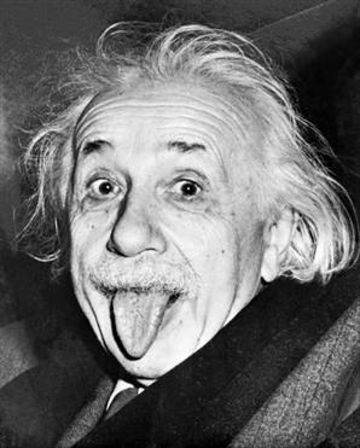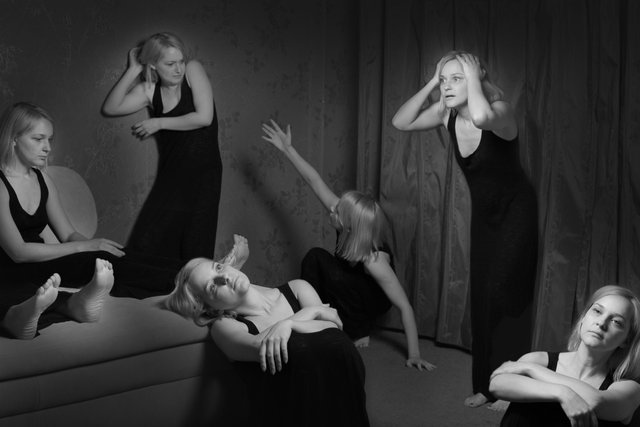Insane over the centuries: admired and feared
Our thinking about madness is highly dependent on the context. In a schizophrenic family member, we consider it a disease to be treated, perhaps a threat to a street swimmer, with an artist, it seems to be a risky byproduct of its creativity or even a prerequisite for great performance.
As for madness and psychiatry, we live in a time of contradictions. There is a romantic haze of genius about madness, but at the same time, everything that is said to psychiatry is feared and tempered. Everyone knows that picture of Albert Einstein on which he puts his tongue out. Because we know that this is a famous and respectable physicist, we see the strange facial expression appropriate to an ingenious scientist.

Albert Einstein
📷Arthur Sasse
Creativity and madness
Behavior that we often judge as problematic, psychically disturbed or even "ill", we find acceptable and perhaps even desirable for those with "creative professions".
This also applies to famous philosophers. Over Wittgenstein's peculiar flaws to his students and friends and his whimsical conversation will be wisely written as belonging to his wisdom.Of artists, we even expect a certain amount of madness. ADHD- like hyperactivity, obsessional fixation at work and manic-depressive mood swings appear to be in line with the life of the artist. An artist who is absolutely normal at all, looses the suspicion that his artwork will not be so "deep" - rightly so, studies show time and time again that there is a relationship between creativity and madness (see, for example, Kay 's work Redfield Jamison).
Pharmaceuticals
This admiration for the genius-insane is accompanied by massive suppression of all that is disturbed. Nowadays, from a very young age, observations and tests are carried out to determine mental disorders - with the criteria for any disorder becoming wider every year. At primary school age, ADHD and autistic children are fished out of the population, followed by bi-polar adolescents and later psychosis- sensitive young adults.
There are more models about normality in circulation in psychology and media than ever before. Medicines that pretend to correct our minds are now among the most widely sold pharmaceuticals . And besides, we still admire the extreme, unapproved sides of the mind without food. We can only understand that diversity of views when we look at how this has developed over time.

Shamanism
In the positive sense of madness, it is an inspiration to learn something about your own deepest motives, essential patterns in the cosmos or even knowledge beyond life and death. Madness is then related to dreams and other state of consciousness. Among the shamans , which occur in many ancient cultures in North Asia, we see for the first time such a positive appreciation for other types of consciousness. The shamans put themselves in the trance and thus made contact with a world of benign and evil demons to turn off evil influences on ordinary life.
Shamanic practices and the accompanying worldview had a strong influence on the way in which later in Western history people were looking at trance. Until today, studies suggest that people with severe psychoses are actually some kind of shamans lost in time.
Greeks
The Greeks also wanted to contact another world for support in adversity. Known as the oracle of Delphi, which was spoken in vertebra, nowadays associated with psychoses, but then considered as messages of gene which, if properly interpreted, were valuable.
In the Greeks, we also find the first theories about madness as a threat to the orderly, harmonious life. Medici from the tradition of Hippocrates rejected the idea that madness had to do with the god world. They believed that in madness - and illnesses in general - the balance was disturbed from the four body fluids : blood, mucus, yellow and black bile. Too much black gal led to blackness or melancholy, while too much blood was associated with mania. Here was laid the foundation for what would be a "bi-polar disorder", two millennia later, a sick mood change.

Hippocrates of Kos
📷Wikimedia Commons
Middle Ages: the fool
Another precursor of today's madness is well visible in the Middle Ages, in the varied variety of silly and foolish. They walked around freely; There were hardly any institutions where they were assembled. Sometimes they worked like others, sometimes they were right at the fairground or they ended up in bedtime.
For some, a career as a darling was possible. In that role, they pushed through to the houses of the clergy and to the medieval courts, and were seen on famine and emerging carnival. They served for entertainment and sometimes teaching when they held people the proverbial mirror.
Soul was used to criticize an over-regulated society. For Erasmus in his praise of souless , it was a necessary counterbalance for reasonableness. Without sweetness, no pleasure, no love, no passion and even no religious conquest. To date, madness in the form of mockery and criticism of customs and customs is a source of inspiration for poets, artists and cabaretists.
Middle Ages: the witch
Not every crazy wax cabaretier avant la lettre. From the end of the Middle Ages, Western societies changed considerably: industry arose, religious disputes expanded and urban populations increased sharply. Part of what were first the (female) dolls, mystics and silly, now got the negative stamp witch on itself. They would engage with the devil and sorcery and be strictly prosecuted.
The emerging (medical) science jumped for them in the bride and relied on reason and humanity to liberate these victims of ignorance and religious madness: witches were not possessed but sick. Initially, this brought them to the rain in the drip. The 'Great Burning' was over, but the time of the Great Enlightenment ( Foucault ) had arrived, often in cruel circumstances.

Witch burn in Willisau (Switzerland), 1447
📷Wikimedia Commons
Modern time
At the beginning of the nineteenth century ideas about madness changed radically. The medical profession made her appearance and for the first time a category of psychiatric patients was distinguished. Under the guidance of nerve practitioners , from the foundations, the parade of the madness began to be an individual physical aberration. The therapies consisted initially of resting, switching , insulin therapy and even lobotomy and electroshocks to help unwind the brain through the brain.
Over the past half century, the use of psychopharmaca to suppress madness has grown tremendously, both inside and outside the décor. Because these drugs have some effect - although rarely the desired effect - the idea arises that madness is primarily a neurological problem. The image of madness in contemporary psychiatry has become particularly unilateral, but very popular.
However, people have remained fascinated with the people who are in the foundations . In addition to fear of the strange and incomprehensible, we still feel madly inspired, ecstasy and creativity.
For the self-laughing fool, we feel pity or aversion, but sometimes we suspect he takes something that leaves us. Thus madness always remains admired as well as feared and perplexed.
Thanks for reading, I hope you liked it!
Steem's Popularity Is Incredible!
Share the joy by inviting others!
Get More Exposure On The Chats!
It is a best way to get more exposure through private messages and in the chat rooms. These are some of the best places to get more exposure & makes Steem friends.
- Official Steemit.chat
- SteemSpeak.com @fyrstikken (24/7 Voice chat)
- Peace, Abundance, Liberty @aggroed @canadian-coconut @ausbitbank @teamsteem and More (Minnow Support Project)
For new & best authors to move forward!
http://curiesteem.com @curie
https://steemvoter.com @steemvoter @thecryptodrive @cryptomancer
My Latest Posts:
- Mouthflora: Good and bad bacteria in your mouth...
- Marvel vs Capcom Infinite Review - Shovel ass with your favorite dream team
- Slow thyroid (hypothyroidism): treatment + symptoms
- The box with insight, human knowledge & dilemmas... Funny STORY!!
- 💖💗💘💕 LOVE talks and funny sayings about love 💕💘💗💖
- Super Mario Odyssey Preview - The trip of your life
- Bitcoin Bubble 2018 Crypto Currency Crash
- Pain between shoulders or shoulder blades: causes & solutions
- NBA 2K18 Review - Forget Pastor
- The story of you and me. Relationships are complex, illogical and inexplicable





Is It Possible To Preserve Ethics And Moral Among Sharks?
Congratulations! This post has been upvoted from the communal account, @minnowsupport, by braini from the Minnow Support Project. It's a witness project run by aggroed, ausbitbank, teamsteem, theprophet0, someguy123, neoxian, followbtcnews/crimsonclad, and netuoso. The goal is to help Steemit grow by supporting Minnows and creating a social network. Please find us in the Peace, Abundance, and Liberty Network (PALnet) Discord Channel. It's a completely public and open space to all members of the Steemit community who voluntarily choose to be there.